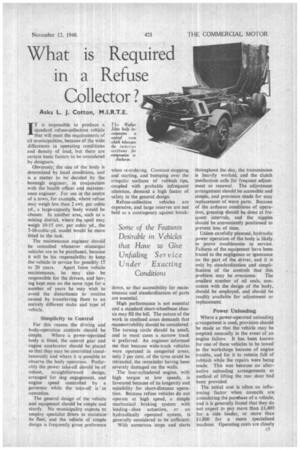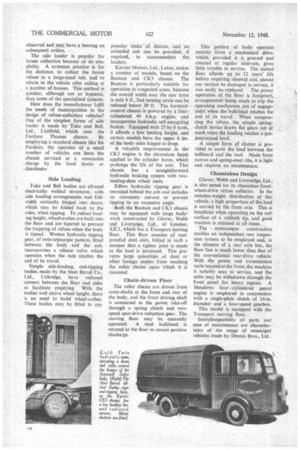What is Required in a Refuse Collector?
Page 43

Page 44

Page 45

If you've noticed an error in this article please click here to report it so we can fix it.
Asks L. J. Cotton, M.I.R.T.E.
IT is impossible to produce a. standard refuse-collection vehicle that will meet the requirements of all municipalities, because of the wide differences in operating conditions and density of load, but there are certain basic factors to be considered by designers.
Obviously; the size of the body is determined by local conditions, and is a matter to be decided by the borough engineer, in conjunction with the health officer and maintenance engineer. For use in the centre of a town, for example, where refuse may weigh less than 2 cwt. per cubic yd., a large-capacity body would be chosen. In another area, such as a mining district, where the spoil may weigh l0-15 cwt. per cubic yd., the 7-10-cubic-yd. model would be more fitted to the task.
The maintenance engineer should be consulted whenever municipal vehicles are to be purchased, because it will be his responsibility to keep the vehicle in service for possibly 15 to 20 years. Apart from vehicle maintenance, he may also be responsible for the drivers, and having kept men on the same type for a number of years he may wish to avoid the disturbance to routine caused by transferring them to an entirely different make and type of vehicle.
Simplicity in Control For this reason the driving and body-operation eontrols should be
simple. Where a power-operated body is fitted, the control gear and engine accelerator should be placed so that they may be controlled simultaneously and where it is possible to observe the body operation. Preferably the power take-off should be of robust, straightforward design, arranged for dog engagement, and engine speed controlled by a governor while the take-off is in operation.
The general design of the vehicle and equipment should be simple and sturdy. No municipality expects to employ specialist fitters to maintainits fleet, and the vehicle of simple design is frequently given preference when re-ordering. Constant stopping and starting, and bumping over the irregular surfaces of rubbish tips, coupled with probable infrequent attention, demand a high factor of safety in the general design.
Refuse-collection vehicles are expensive, and large reserves are not held as a contingency against break
down, so that accessibility for maintenance and standardization of parts are essential.
High performance is not essential and a standard short-wheelbase chassis may fill the bill. The nature of the work in confined areas demands that manteuvrability should be considered. The turning circle should be small, and in most cases a narrow track is preferred. An engineer informed me that because wide-track vehicles were operated in congested areas, only 2 per cent. of the tyres could be retreaded, the remainder having been severely damaged on the walls.
The four-cylindered engine, with high torque at low speeds, is favoured because of its longevity and suitability for short-distance operation. Because refuse vehicles do not operate at high speed, a simple mechanical braking system with leading shoe actuation, or an hydraulically operated system, is generally considered to be sufficient.
With numerous stops and starts throughout the day, the transmission is heavily worked, and the clutch mechanism calls for frequent adjust ment or renewal. The adjustment arrangement should be accessible and simple, and provision made for easy replacement of worn parts. Because of the arduous conditions of operation, greasing should be done at frequent intervals, and the nipples should be conveniently positioned to prevent loss of time.
Unless carefully planned, hydraulic power operation of the body is likely , to prove troublesome in service. Failures of the equipment have been traced to the negligence or ignorance on the part of the driver, and it is only by standardization and simplification of the controls that this problem may be overcome. The smallest number of oil seals, consistent with the design of the body, should be employed, and should be readily available for adjustment or replacement.
Power Unloading Where a power-operated unloading arrangement is used, provision should be made so that the vehicle may be emptied manually in the event of an engine failure. It has been known for one of these vehicles to be towed to the workshops because of engine trouble, and for it to remain full of rubbish while the repairs were being made. This was because no alternative unloading arrangements or method of lifting the rear door had been provided.
The initial cost is often an influencing factor when councils are considering the purchase of a vehicle, and it is generally found that they do not expect to pay more than £1,400 for a side loader, or more than £1,800 for a more specialized machine. Operating costs are closely
observed and may have a bearing on subsequent orders.
The side loader is popular for house collectiOn because of its simplicity. A common practice is for the dustman to collect the house refuse in a large-sized tub, and to return to the vehicle after calling at a number of houses. This method is quicker, although not so hygienic, than some of the specialized systems.
How does the manufacturer fulfil the needs of municipalities in the design of refuse-collection vehicles? One of the simplest forms of side loader is made by Tuke and Bell. Ltd., Lichfield, which uses the Fordson Thames chassis. By employing a standard chassis like the Fordson, the operator of a small number of vehicles can have the chassis serviced at a reasonable charge by the local dealer or distributor.
Side Loading
Tuke and Bell bodies are all-steel electrically welded structures, with side loading arrangements and fullwidth vertically hinged rear doors, which may be folded back to the sides, when tipping. To reduce loading height, wheel-arches are built into the floor and are tapered to prevent the trapping of refuse when the body is tipped. Weston hydraulic tipping gear, of twin-telescopic pattern, fitted between the body and the cab, incorporates a release valve which operates when the ram reaches the end of its travel.
Simple side-loading, end-tipping bodies made by the Steel Barrel Co., Ltd., Uxbridge, have radiused corners between the floor and sides to facilitate emptying. With the bodies well above wheel h,eight, there is no need to build wheel-arches. These bodies may be fitted to any
popular make of chassis, and an extended cab can be provided, if required, to accommodate the loaders.
Karrier Motors, Ltd., Luton, makes a number of models, based on the Bantam and CK3 chassis. The Bantam is particularly suitable for operation in congested areas, because the overall width over the rear tyres is only 6 ft. 5nd turning circle can be reduced below 30 ft. The forwardcontrol chassis is powered by a fourcylindered 40 b.h.p. engine, and incorporates hydraulic self-energizing brakes. Equipped with 25 by 6 tyres, it affords a low loading height, and certain models have the upper 6 ins. of the body sides hinged to drop.
A valuable improvement in the CK3 engine is the chromium finish applied to the cylinder bores, which prolongs the life of the unit. This chassis has a straightforward hydraulic braking system with twoleading-shoe wheel units.
Edbro hydraulic tipping gear is mounted behind the cab and includes an automatic cut-out to prevent tipping to an excessive angle.
• Both the Bantam and CK3 chassis may be equipped with large bodywork constructed by Glover, Webb and Liversidge. Ltd., of London, S.E.1, which has a Transport moving floor. This floor consists of rustproofed steel slats, linked in such a manner that a tighter joint is made as the load is increased. This prevents large quantities of dust or other foreign matter from reaching the roller chains upon which it is mounted.
Chain-driven Floor
The roller chains are driven from cross-shafts at the front and rear of the body, and the front driving shaft is connected to the power take-off through a spring clutch and twospeed spur-drive reduction gear. The moving floor may be manually operated. A steel bulkhead is secured to the floor to ensure positive discharge.
This pattern of body operates entirely from a mechanical drive. which, provided it is greased and cleaned at regular intervals, gives little trouble in service. The slatted floor affords up to 12 years' life• before requiring renewal and, should any section be damaged in service, it can easily be replaced. The power operation of the floor is foolproof, arrangements being made to trip the operating mechanism out of engagement when the bulkhead reaches the end of , its travel. When compressing the refuse, the simple springClutch device draws the gears out of mesh when the loading reaches a predetermined level.
A simple form of shutter is provided to cover the load between the tailboard and the roof. Made from canvas and spring-steel ribs, it is light and requires no maintenance.
Chassiskss Design Glover, Webb and Liversidge, Ltd.. is also noted for its chassisless frontwheel-drive refuse collector. In the unladen-weight distribution of this vehicle, a high proportion of the load is carried by the front axle. This is beneficial when operating on the soft surface of a rubbish tip, and good traction is attained at all times.
The . monocoque construction enables an independent rear suspension system to be employed and, in the absence of a rear axle bar, the floor line is much lower than that of the conventional rear-drive vehicle. With the power and transmission units located at the front, the machine is notably easy to service, and the units may be withdrawn through the front panel for heavy repairs. A Meadows ' four cylindered petrol engine is employed in conjunction with a single-plate clutch of 14-in. diameter and a four-speed gearbox.
This model is equipped with the Transport moving floor.
Interchangeability of parts and ease of maintenance are characteristics of the range of municipal vehicles made by Dennis Bros., Ltd.. Guildford. These are powered by a four-cylindered petrol engine, and the cabs of the forward-control models may be removed for major repairs to the engine or transmission.
Built to withstand heavy stresses, the frame and its component members are bolted together to enable damaged parts to be easily replaced. All the side-loading models are equipped with 27-in. by 6-in. tyres. and the chassis are designed to afford a low loading line. Accommodation is provided for loaders, and the body is wider at the rear than at the front to obtain a steady discharge when tipping.
The Paxit mechanically operated rear loader includes a hydraulically actuated ram to carry the refuse forward in the body, which is tipped by hydraulic gear.
Shelvoke and Drewry, Ltd., Letchworth, specializes in municipal equipment, and all its vehicles are low loaders with small turning circles. 'The cabs arc designed to afford maximum visibility, and the position of the controls is standardized.
The four-cylindered engine has many features embodied in its design to afford economical operation with the minimum of wear. A thermostat is provided in the cylinder head.
The pump for the twin-ram tipping gear is driven direct from the end of the gearbox layshaft without intermediate gears. To make the system easy to control, an interlocking arrangement, between the engine accelerator and pump-engaging lever, prevents the vehicle from being driven with the pump in operation, and sets the engine to run at the correct speed for tipping whenever the pump is engaged.
Another concern specializing in refuse-collection vehicles is Walkers and County Cars, Ltd., Wigan. The new tractor and trailer combination described elsewhere in this issue is a development of the highly successful Paragon. The Jekta body, in which the interior sections are telescoped for compression or discharge, also has its uses in providing access to the chassis for maintenance. With the body in the closed position, a fitter can stand inside the chassis frame to service the components.
The Lewin-Oschner body, which is fitted by Lewin Road Sweepers, Ltd., West Bromwich, to the Austin 5-tonner, affords the maximum of accessibility for maintenance of the body control gear and the chassis, when in the open position. The layout and operation of the hydraulic system are simple, and the number of moving parts is comparatively small.
Naturally, the larger capacity vehicles, with ram-compression attachments, generally tend to increase the number of hydraulic components in the chassis, which usually means that there are more parts to service. The Scammell Essloo, although a large machine, is an example of simplicity in general arrangement, and the method of tipping the rear loading hopper ensures that the body becomes fully loaded from bulkhead to tailboard.
Movement of the hopper, which is operated from the rear of the vehicle, is fully automatic, and demands no great skill from the loader. A single positive movement of the control handle is sufficient to work the hopper and close the rear doors. There is little required in the way of maintenance apart from checking the oil level of the fluid and lubricating the hopper traverse pulleys.
Another model of simple operation is the Lewin compressing refuse collector, which has a cylindrical loadcarrying body. An impeller, chaindriven from the power take-off, gathers the bin contents, passes the refuse forward and compresses it against the front end of the cylinder. The cylindrical drum is revolved to empty the container. This pattern of body requires little maintenance and, apart from that required for the rear door of the container, there is no other hydraulic mechanism.




























































































